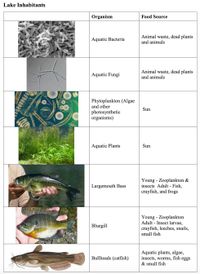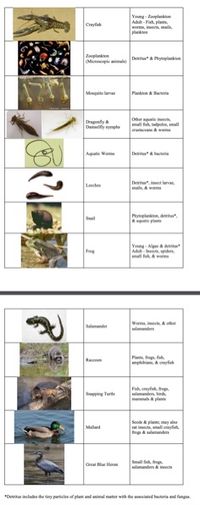
Human Anatomy & Physiology (11th Edition)
11th Edition
ISBN: 9780134580999
Author: Elaine N. Marieb, Katja N. Hoehn
Publisher: PEARSON
expand_more
expand_more
format_list_bulleted
Question
You will be examining the relationship among organisms inhabiting a small lake. Examine the “Lake Inhabitants” sheet for information about the organisms found in the lake.
- What biotic and abiotic factors will affect the aquatic plants in the lake?
- What biotic and abiotic factors will affect the bluegill in the lake?
- Looking at the organisms associated with the lake, organize them into three trophic groups: producers, consumers, and decomposers.
- Separate the consumers into three subcategories: herbivores, carnivores, and omnivores.
- Create 3 different food chains found within the lake. Food chain #1 should contain 3 organisms, food chain #2 should contain 4 organisms, and food chain # 3 should contain 5 organisms. The arrows should point in the direction the energy is flowing through the food chain. You can either use the “>” as your arrow or the Insert Symbol function to insert an arrow into your food chains.
- As the energy flows through each trophic level, how much energy is lost from the food chain as heat?
- What happens to the number of organisms as they go up through the trophic levels? Explain why this occurs.

Transcribed Image Text:**Lake Inhabitants**
| **Organism** | **Food Source** |
|-----------------------------|---------------------------------------------------------------------------|
| Aquatic Bacteria | Animal waste, dead plants and animals |
| Aquatic Fungi | Animal waste, dead plants and animals |
| Phytoplankton (Algae and other photosynthetic organisms) | Sun |
| Aquatic Plants | Sun |
| Largemouth Bass | Young - Zooplankton & insects Adult - Fish, crayfish, and frogs |
| Bluegill | Young - Zooplankton Adult - Insect larvae, crayfish, leeches, snails, small fish |
| Bullheads (catfish) | Aquatic plants, algae, insects, worms, fish eggs & small fish |
**Explanation of Images:**
1. **Aquatic Bacteria:** The image shows microscopic organisms that help decompose waste material in the lake.
2. **Aquatic Fungi:** Depicted as thread-like structures, fungi play a role in breaking down dead organic matter.
3. **Phytoplankton:** The image displays a collection of microscopic algae that perform photosynthesis, serving as a primary food source in aquatic environments.
4. **Aquatic Plants:** This image shows a variety of underwater plants that use sunlight for photosynthesis, contributing to oxygen production in the water.
5. **Largemouth Bass:** Illustrated holding a fish, this species is a predator at the top of the lake's food chain, preying on smaller aquatic animals.
6. **Bluegill:** A colorful fish depicted in the image, the bluegill is both a predator of smaller organisms and prey for larger fish.
7. **Bullheads (catfish):** Shown as a bottom-feeder, this species has a varied diet including plants and small aquatic animals.

Transcribed Image Text:### Aquatic and Semi-Aquatic Food Web
#### Organisms and Their Diets
1. **Crayfish**
- **Diet:**
- *Young:* Zooplankton
- *Adult:* Fish, snails, insects, plant matter, detritus*
2. **Zooplankton (Ostracods & others)**
- **Diet:** Detritus* & Phytoplankton
3. **Mosquito larvae**
- **Diet:** Plankton & Bacteria
4. **Dragonfly & Damselfly nymphs**
- **Diet:** Other aquatic insects, worms, crustaceans, small fish, tadpoles
5. **Aquatic Worms**
- **Diet:** Detritus* & Bacteria
6. **Leeches**
- **Diet:** Detritus*, insect larvae, snails & worms
7. **Snail**
- **Diet:** Phytoplankton, detritus* & aquatic plants
8. **Frog**
- **Diet:**
- *Young:* Algae & detritus*
- *Adult:* Insects, snails, small fish, & worms
---
9. **Salamander**
- **Diet:** Worms, insects, & other invertebrates
10. **Raccoon**
- **Diet:** Plants, frogs, fish, crayfish, & turtles
11. **Snapping Turtle**
- **Diet:** Fish, crayfish, frogs, aquatic birds, plants, & some carrion
12. **Mallard**
- **Diet:** Seeds & plant, insects, crustaceans, algae & small fish
13. **Great Blue Heron**
- **Diet:** Small fish, frogs, salamanders & insects
---
*Note: Detritus includes the tiny particles of plant and animal matter with the associated bacteria and fungi.*
### Explanation of Graphs or Diagrams
This diagram presents a detailed depiction of an aquatic and semi-aquatic ecosystem food web. Each organism is accompanied by an image and a list of dietary preferences, demonstrating the complexity of food relationships in these environments. The diagram aids in understanding the role of each organism within the ecosystem by illustrating their feeding habits and connections to other species.
Expert Solution
This question has been solved!
Explore an expertly crafted, step-by-step solution for a thorough understanding of key concepts.
This is a popular solution
Trending nowThis is a popular solution!
Step by stepSolved in 2 steps

Knowledge Booster
Learn more about
Need a deep-dive on the concept behind this application? Look no further. Learn more about this topic, biology and related others by exploring similar questions and additional content below.Similar questions
- The Lazy River Environmental Group organized a major cleanup of the pollution from the old factory in late 2010. Measurements of pollution in river sediments before and after the cleanup were analyzed to determine the effectiveness of the cleanup. Select the Sediment Pollutant Over Time dataset and follow the interactive to graph the data. What statement best describes the results of the clean up?arrow_forwardBox 1 Please match the correct components of the nitrogen cycle to each numbered box. Not every word will match a box. Atmospheric nitrogen (N2226) 1 Producers Leaching. Soil Consumers Detritivores, scavengers, decomposers 3 Producers Consumers Detritivores scavengers, decomposers Nitrate (NO) 2 Ammonia (NEC) ammonium (NH) Nitrite (NO) 4 5 Relyea, Ecology. 9e, 2021 W. H. Freeman and Companyarrow_forwardhow to maintain a continuous healthy terrestrial ecosystem . Consider the following in your recommendation (human disturbance, patch size, disturbance frequency, global climate change/el nino)arrow_forward
- You are studying primary productivity and biodiversity patterns of an ecosystem. The ecosystem is represented by the climatograph below. The Gross Primary Productivity (GPP) is measured to be 5000 grams of carbon per square meter per year, and the Total Respiration (RT) is measured to be 300 grams of carbon per square meter per year. - What kind of biome is this? - Calculate the Net Ecosystem Production (NEP) for this ecosystem - What does the calculated NEP value indicate about the carbon balance and overall productivity of the ecosystem? (one sentence) - Based on both the climatograph and the NEP, what can you say about the biodiversity of plants versus consumers? Choice 1 of 4:plant biodiversity is greater than consumer biodiversity Choice 2 of 4:consumer biodiversity is greater than plant biodiversity Choice 3 of 4:consumer biodiversity is the same as plant biodiversity Choice 4 of 4:lower plant biodiversity compared to consumer biodiversityarrow_forwardhttp://www.fao.org/nr/water/aquastat/data/query/index.html?lang=en. Step 1. Choose five nations (including the United States) from the enormous database by clicking the corresponding boxes. For "select variables", choose these three: 1. Under "Water Resources" choose "Total Renewable Water Resources" and within that choose only "Total Renewable Water Resources per Capita. 2. Choose "Water Use" and then "Pressure on Water Resources" . Within that subset choose only"SDG 6.4.2 Water Stress". "SDG" means the Sustainable Development Goal. This value is the percentage of total available water that is used by a nation. 3. Under "Water Use" choose "Water Withdrawal by Sector", and within that choose only "Total Water Withdrawal per Capita". Nation Resources per Capita Withdrawal per Capita % Water Stress: withdrawal vs. resources) Step 2. Based…arrow_forwardNote: Since you have posted a question with multiple sub-parts, we will solve the first three sub-parts for you. To get the remaining sub-part solved please repost the complete question and mention the sub-parts to be solved. Carrying capacity: The resources present in the ecosystem are utilised by all the organisms that grow and thrive in the ecosystem. Since the resources present are limited the environment can support only a limited number of organisms. The maximum number of organisms that the environment can support is called the carrying capacity. Above the carrying capacity, there is completion for the limited resources. Step 2 1. When we see the data representing the deer population from 1905-1939 we see that there has been a rapid increase in the deer population initially and then the population falls down drastically. In the year 1915 The carrying capacity for the Kaibab deer population was 30.000 deers for 30,000 hectares of land. If the see the deer…arrow_forward
- Name the three main loopsof the hydrologic cycle. Then, describe how each of the three main loops operates to purify water in the biosphere. (Tell what happens in each loop that purifies the water.)arrow_forwardDefine the problem: What problem are you trying to address as an environmental engineer? Explain the repercussions of this problem on the Kalba sea and the whole coastline area. Aside from marine organisms, who would be affected by this problem? Would you consider this oil spill to be particularly severe for taking place in summer during the month of August? Compare the effects of this oil spill if it were to take place in the month of February.arrow_forwardWhat are the two key concepts for this section?Define freshwater. Explain why access to water is ahealth issue, an economic issue, a national and globalsecurity issue, and an environmental issue. Whatpercentage of the earth’s freshwater is available to us?Explain how water is recycled by the hydrologic cycleand how human activities can interfere with thiscycle. Define groundwater, zone of saturation,water table, aquifer, surface water, surface runoff, and watershed basinarrow_forward
- What's the difference between oligotrophic lakes and eutrophic lakes? Describe how "and what happens to the lake when human activities contribute to the formation of one of these types. This is the initial textarrow_forwardA lake with low nutrient levels and very clear water is called eutrophic oligotrophic a dead zone a septic zone oxygen depletedarrow_forwardSEAWEED ORCA SQUID MACKEREL HUMAN TUNA RED ALGAE PHYTOPLANKTON MILYFISH Using the food web to the left, complete the following: Name two primary producers: What are the two apex predators? In the space provided, create a food chain that contains 4 organisms:arrow_forward
arrow_back_ios
SEE MORE QUESTIONS
arrow_forward_ios
Recommended textbooks for you
 Human Anatomy & Physiology (11th Edition)BiologyISBN:9780134580999Author:Elaine N. Marieb, Katja N. HoehnPublisher:PEARSON
Human Anatomy & Physiology (11th Edition)BiologyISBN:9780134580999Author:Elaine N. Marieb, Katja N. HoehnPublisher:PEARSON Biology 2eBiologyISBN:9781947172517Author:Matthew Douglas, Jung Choi, Mary Ann ClarkPublisher:OpenStax
Biology 2eBiologyISBN:9781947172517Author:Matthew Douglas, Jung Choi, Mary Ann ClarkPublisher:OpenStax Anatomy & PhysiologyBiologyISBN:9781259398629Author:McKinley, Michael P., O'loughlin, Valerie Dean, Bidle, Theresa StouterPublisher:Mcgraw Hill Education,
Anatomy & PhysiologyBiologyISBN:9781259398629Author:McKinley, Michael P., O'loughlin, Valerie Dean, Bidle, Theresa StouterPublisher:Mcgraw Hill Education, Molecular Biology of the Cell (Sixth Edition)BiologyISBN:9780815344322Author:Bruce Alberts, Alexander D. Johnson, Julian Lewis, David Morgan, Martin Raff, Keith Roberts, Peter WalterPublisher:W. W. Norton & Company
Molecular Biology of the Cell (Sixth Edition)BiologyISBN:9780815344322Author:Bruce Alberts, Alexander D. Johnson, Julian Lewis, David Morgan, Martin Raff, Keith Roberts, Peter WalterPublisher:W. W. Norton & Company Laboratory Manual For Human Anatomy & PhysiologyBiologyISBN:9781260159363Author:Martin, Terry R., Prentice-craver, CynthiaPublisher:McGraw-Hill Publishing Co.
Laboratory Manual For Human Anatomy & PhysiologyBiologyISBN:9781260159363Author:Martin, Terry R., Prentice-craver, CynthiaPublisher:McGraw-Hill Publishing Co. Inquiry Into Life (16th Edition)BiologyISBN:9781260231700Author:Sylvia S. Mader, Michael WindelspechtPublisher:McGraw Hill Education
Inquiry Into Life (16th Edition)BiologyISBN:9781260231700Author:Sylvia S. Mader, Michael WindelspechtPublisher:McGraw Hill Education

Human Anatomy & Physiology (11th Edition)
Biology
ISBN:9780134580999
Author:Elaine N. Marieb, Katja N. Hoehn
Publisher:PEARSON

Biology 2e
Biology
ISBN:9781947172517
Author:Matthew Douglas, Jung Choi, Mary Ann Clark
Publisher:OpenStax

Anatomy & Physiology
Biology
ISBN:9781259398629
Author:McKinley, Michael P., O'loughlin, Valerie Dean, Bidle, Theresa Stouter
Publisher:Mcgraw Hill Education,

Molecular Biology of the Cell (Sixth Edition)
Biology
ISBN:9780815344322
Author:Bruce Alberts, Alexander D. Johnson, Julian Lewis, David Morgan, Martin Raff, Keith Roberts, Peter Walter
Publisher:W. W. Norton & Company

Laboratory Manual For Human Anatomy & Physiology
Biology
ISBN:9781260159363
Author:Martin, Terry R., Prentice-craver, Cynthia
Publisher:McGraw-Hill Publishing Co.

Inquiry Into Life (16th Edition)
Biology
ISBN:9781260231700
Author:Sylvia S. Mader, Michael Windelspecht
Publisher:McGraw Hill Education